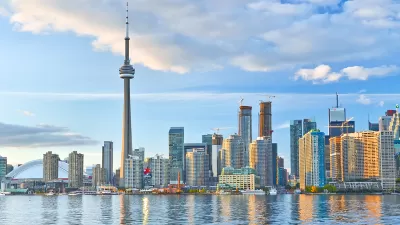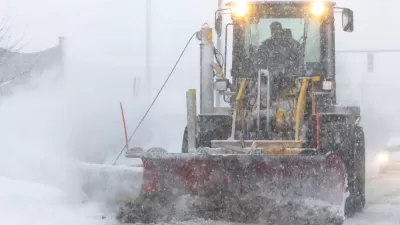With fifteen skyscrapers over 45 stories under construction, Toronto is erecting more tall buildings than any other city in the Western Hemisphere. By 2015, the city is expected to have more than triple the number of skyscrapers than in 2005.
According to a new study by the Council on Tall Buildings and Urban Habitat, Toronto is "spearheading a countrywide interest in tall building development." The city has increased construction of not only highrise office towers, but also tall residential buildings like the 277-metre Trump International Hotel and Candarel's 272-metre condo project. "There's no doubt that Canada is at the forefront of discussion around how to create more vibrant urban centres, increase density and build more sustainable cities," said Kevin Brass, Council spokesperson.
In the last eight years, 25 buildings of more than 150 metres have been constructed in Canada compared to only five between 1995 and 2005. Toronto ranks first in Canada with 30 buildings over 150 metres, and the newest skyscrapers are commonly 60 stories, compared to the average of 30 to 35 ten years ago. "We're turning into a very exciting city," said Riz Dhanji, vice president of sales and marketing for Canderel Residential Group, "The tall buildings are bringing the density and the people into the downtown core and making us more of a walkable city, which is fantastic."
The Council voted Winnipeg's 22-story Manitoba Hydro Place "the best tall building in the Americas" in 2009 and recognized Mississauga's 50- and 56-story Absolute World with the same award last June. The group may soon hold its annual conference in Canada for architects and building professionals to get a firsthandlook at the North American leader's highrise developments. Antony Wood, the Council's executive director, said, "When Canada wins the best tall building in the Amercas twice in four years, you kind of think to yourself, there's something good going on up there."
FULL STORY: Toronto leading the western world in high highrise development

Study: Maui’s Plan to Convert Vacation Rentals to Long-Term Housing Could Cause Nearly $1 Billion Economic Loss
The plan would reduce visitor accommodation by 25,% resulting in 1,900 jobs lost.

Placekeeping: Setting a New Precedent for City Planners
How a preservation-based approach to redevelopment and urban design can prevent displacement and honor legacy communities.

Using Old Oil and Gas Wells for Green Energy Storage
Penn State researchers have found that repurposing abandoned oil and gas wells for geothermal-assisted compressed-air energy storage can boost efficiency, reduce environmental risks, and support clean energy and job transitions.

Washington State Plans Ambitious ‘Cycle Highway’ Network
The state is directing funding to close gaps in its existing bike network and make long-distance trips more accessible.

Homeowners Blame PG&E for Delays in ADU Permits
The utility says it has dramatically reduced its backlog, but applicants say they still face months-long delays for approvals for new electrical work.

Rethinking Wildfire Defense: How a Landscape Approach Can Protect Neighborhoods
Post-fire analysis of the Eaton Fire reveals that a landscape approach — including fire-resistant vegetation, home hardening, and strategic planning — can help reduce wildfire risk, challenging assumptions that trees and plants are primary fire hazards.
Urban Design for Planners 1: Software Tools
This six-course series explores essential urban design concepts using open source software and equips planners with the tools they need to participate fully in the urban design process.
Planning for Universal Design
Learn the tools for implementing Universal Design in planning regulations.
Borough of Carlisle
Caltrans
Heyer Gruel & Associates PA
Institute for Housing and Urban Development Studies (IHS)
City of Grandview
Harvard GSD Executive Education
Salt Lake City
NYU Wagner Graduate School of Public Service
City of Cambridge, Maryland





























